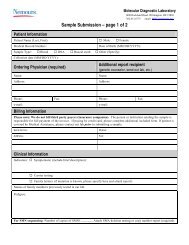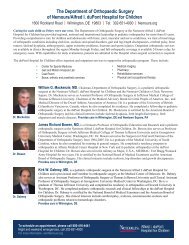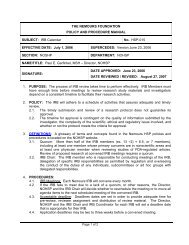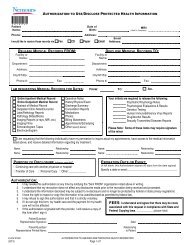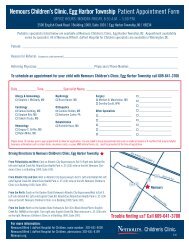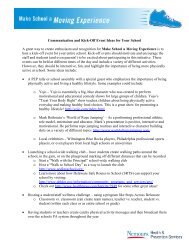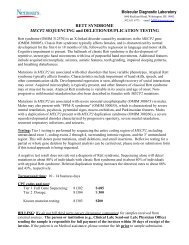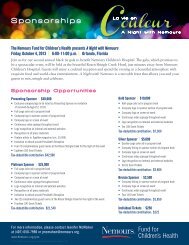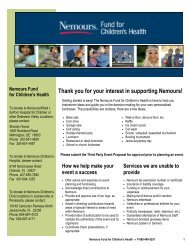Best Practices for Healthy Eating Guide - Nemours
Best Practices for Healthy Eating Guide - Nemours
Best Practices for Healthy Eating Guide - Nemours
You also want an ePaper? Increase the reach of your titles
YUMPU automatically turns print PDFs into web optimized ePapers that Google loves.
Tip Sheet: <strong>Healthy</strong> <strong>Eating</strong> <strong>for</strong> Toddlers Ages 3 through 5 Years<br />
Encouraging <strong>Healthy</strong> <strong>Eating</strong> Habits<br />
• Start with age-appropriate servings, as listed in the<br />
chart on the next page.<br />
• Teach him to eat slowly. Ask if he is still hungry be<strong>for</strong>e<br />
allowing him to serve himself more food. Taking the<br />
time to decide if he is hungry or full will help him pay<br />
attention to important cues from his body.<br />
• Avoid requiring your child to clean her plate. Help her<br />
learn to eat based on how hungry she is, not on how<br />
much food is still on her plate.<br />
• Understand your role and your child’s. Your job is to<br />
offer a variety of healthy foods at regular meal times;<br />
his job is to decide what and how much to eat.<br />
• Be a positive role model. Sit with your child and let<br />
her observe you eat a healthy, balanced diet. Serve<br />
yourself appropriate portions and try “new” foods.<br />
Eat when you are hungry and stop when you are full,<br />
even if there is food left on your plate. Talk about<br />
what you are doing.<br />
• Pay attention to your preschooler’s cues. He may not<br />
say that he is full, but may show it by starting to play,<br />
becoming distracted, shaking his head “no,” pushing<br />
food around on his plate or simply refusing to eat.<br />
• Complaints of being hungry, especially when a child<br />
has just eaten, may be due to other triggers such as<br />
boredom, TV advertising or seeing another person<br />
eating.<br />
• Given healthy servings, most children can sense when<br />
they are full and will stop eating if you let them. The<br />
amount of food a preschooler eats may change from<br />
day to day, but a healthy child will generally consume<br />
just the right amount of food to nourish her body.<br />
Trying New Foods<br />
It is natural <strong>for</strong> preschoolers to be cautious about trying<br />
new foods; but remember that by and large, they should<br />
eat what the rest of the family is eating. If you are eating<br />
and enjoying a variety of healthy foods, they won’t want<br />
to be left out.<br />
• When offering a new food, feed a familiar food with<br />
the new one, alternating bites between each.<br />
• Some children are less likely than others to try new<br />
things. It may take her 5 – 20 times of trying a new<br />
food be<strong>for</strong>e she will like it. Don’t give up!<br />
• Encourage your child to try new foods—at least one<br />
bite. Begin by putting a small amount on his plate<br />
(e.g., two peas). However, do not <strong>for</strong>ce him to finish<br />
more than he feels com<strong>for</strong>table eating.<br />
• Model trying new foods. Try a new fruit or vegetable<br />
and talk about how it looks, smells and tastes.<br />
• Avoid rewarding good behavior or a clean plate with<br />
foods of any kind. Especially avoid <strong>for</strong>cing your child<br />
to finish the “healthy foods” to get dessert or sweets—<br />
this can make the healthy food seem like punishment<br />
and <strong>for</strong>ce her to eat when she is full.<br />
• Offer desserts rarely so he does not expect one at<br />
every meal.<br />
How Much to Feed Your Child<br />
Understand your role and your child’s role at mealtimes.<br />
Your job is to offer healthy foods at regular times; your<br />
child’s job is to decide whether and how much to eat.<br />
Ask your healthcare provider if you have any questions<br />
about feeding your child.<br />
Choking Hazards<br />
Do not feed children younger than four years of age round, firm food<br />
unless it is chopped completely.<br />
The following foods are choking hazards:<br />
n Nuts and seeds<br />
n Large chunks of cheese or meat (e.g., hot dogs)<br />
n Whole grapes, chunks of hard fruit (e.g., apples) and raw<br />
vegetables<br />
n Peanut butter<br />
n Ice cubes<br />
n Raisins<br />
n Popcorn<br />
n Hard, gooey, or sticky candy, chewing gum<br />
*Never leave a young child unattended while she/he is eating.<br />
<strong>Best</strong> <strong>Practices</strong> <strong>for</strong> <strong>Healthy</strong> <strong>Eating</strong> 63



